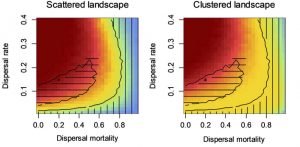The general idea about expansion dynamics is that everything happens on the expansion front: the few individuals that first manage to colonize ahead of the main population will drive the expansion further. This is called a “pulled” wave, as these guys on the front are more or less pulling the whole population forward.
Quite recently, it has become obvious that there were many cases in which this scenario could not work, mostly because populations on the front are really small, and small populations can have LOTS of trouble. For instance, if the population suffers from an Allee effect (i.e., a reduced growth rate at low density), the population on the front needs to be large enough so that the number of migrants it sends further is sufficient to colonize successfully. Same thing if the individuals disperse only when their local environment gets crowded (positive density-dependent dispersal). Or just if dispersal is a rare and stochastic event, you need to have a big enough population to draw from to get the few migrants necessary for successful colonization. In all these cases, the propagation wave will be “pushed”, because the core population at the rear will be the real demographic engine behind expansion.
Lately, I have been investigating the mechanisms inducing pushed waves, their consequences for expansion patterns in heterogeneous landscapes, and their evolutionary dynamics.

Spreading speed in a stepping-stone landscape depending on the carrying capacity of habitat patches (from Haond et al. 2018)

Number of patches colonized in a scattered or a clustered landscape, depending on dispersal rate and dispersal mortality (simulation results, from Morel-Journel et al. 2018 Ecography)
Funding sources: INRA (SPE 2010-2013) ; ANR (Triptic 2014-2018 ; PushToiDeLa 2019-2022)
